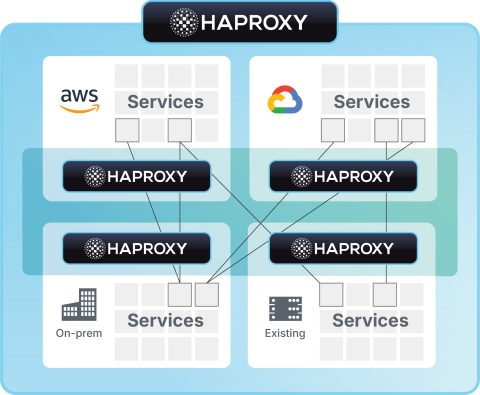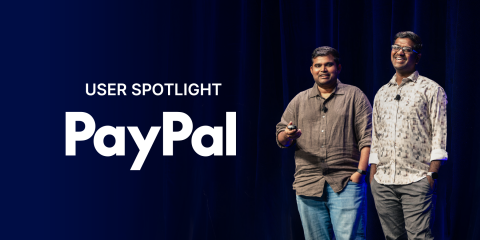One mesh. Every cloud. Ultimate simplicity.
Stop shifting complexity. Start simplifying connectivity. Unify your multi-cloud, on-prem, and legacy applications with a single architectural pattern that converges ingress, egress, and service mesh into one.

The "mesh tax" is too high — and it still doesn't solve the real problem.
Organizations manage hundreds of services deployed across new and old infrastructure. Traditional service meshes were designed for a pristine, cloud-native-only world. They promised to solve connectivity, but for most enterprises, they simply shifted the complexity elsewhere:
Massive resource overhead – The mesh tax of running a proxy for every pod consumes significant CPU and memory, adding latency to each request.
Operational burden – Teams must manage, upgrade, and secure thousands of distributed sidecars, creating new challenges.
Poor hybrid-cloud support – Meshes were never designed to connect legacy apps, VMs, and bare-metal servers.
Fragmented traffic management – Meshes only handle east-west (pod-to-pod) traffic, forcing you to buy and manage separate, disconnected tools for ingress, egress, and API gateways.
Infrastructure is distributed
80% of organizations rely on multiple private and public clouds to host their services.
Fragmentation is rampant
59% of survey respondents use three or more tools to manage their cloud infrastructure.
Management is complex
Enterprises use, maintain, and manage communication between 364 SaaS apps, on average.
Focus on the boundary, not the service
Universal mesh represents a fundamental convergence of technologies. Your ingress, egress, internal mesh, and API gateway proxies become one unified data plane, all managed by one control plane for effortless multi-cluster federation.
Instead of deploying proxies on every pod, you deploy strategic HAProxy Enterprise gateways at the boundary of each environment. HAProxy Fusion Control Plane provides centralized management, observability, and automation.

One architecture, two core patterns
Our universal mesh is fractal. The same simple, powerful architecture applies at every scale, from a single cluster to a global hybrid cloud. Deploy strategic gateways at the boundaries of your K8s clusters, VPCs, and on-prem datacenters. These gateways form the powerful, performant "universal mesh edge." Users get the same HAProxy One features both at the inner and outer edge.
The outer edge (north-south traffic)
Manage all traffic entering or leaving your infrastructure. This becomes your single, strategic control point for application DDoS protection, web application firewall (WAF), bot management, and unified ingress/egress routing.
The inner edge (east-west traffic)
Connect applications across clusters, clouds, and data centers with explicit, logical routing. Solve overlapping IP address spaces, connect K8s services to legacy VMs, and enable end-to-end mTLS — with unrivaled observability.
Unified ingress and routing
Intelligent external load balancing, multi-cluster routing, direct-to-pod load balancing, and high-performance ingress for Kubernetes apps. Centrally manage all routing, configuration, and security.
Learn moreMulti-layered security
Fend off today's and tomorrow's biggest cybersecurity threats with HAProxy One. Harness DDoS protection, bot management, web application firewall, API gateway, TLS termination, mTLS support, and more.
Learn moreAPI gateway
Help your APIs and services scale massively, complete with HAProxy's legendary performance, security, and reliability features. Empower your teams to manage your multi-gateway, multi-cloud API gateway deployments.
Learn moreObservability
All your traffic, clusters, and clouds in one place. Identify performance, security, and capacity issues before they become a problem.
Learn moreSimplifying modern connectivity
Enable more seamless and secure connectivity and connect systems across different environments, such as business units, cloud regions, and outside partners. Universal Mesh allows both Kubernetes and non-Kubernetes services to communicate seamlessly, no matter where they're located.
Easily implement a streamlined approach to security, observability, and scalability that integrates with existing brownfield services and Kubernetes fundamentals — without altering network fundamentals.
Ensure unified app delivery and build your cloud infrastructure your way
Learn how HAProxy One makes it easier to connect services spanning multiple clouds, without adding unnecessary complexity.
Eliminate the mesh tax
Remove the need for sidecars to drastically reduce resource overhead (CPU, memory) and eliminate extra latency on every request — saving you real money on your cloud bill and compute resources.
Simpler, explicit networking
Govern all north-south and east-west traffic with a single, easy-to-understand architecture. Replace "transparent magic" with explicit routing that's easy to debug.
Easier monitoring and troubleshooting
HAProxy Fusion’s centralized monitoring correlates traffic across boundaries with a single request ID, giving you true end-to-end tracing across clouds.
Deliver apps and services faster
HAProxy Fusion supports self-service via a modern GUI or API — enabling automation for the entire software development lifecycle. Onboard new services in minutes, not months.
Do more with HAProxy One
The world's fastest application delivery and security platform seamlessly blends data plane, control plane, and edge network to deliver the world's most demanding applications, APls, and Al services in any environment.

HAProxy Enterprise
A flexible data plane layer that provides high-performance load balancing, an API/Al gateway, Kubernetes application routing, best-in-class SSL processing, and multi-layered security.
HAProxy Fusion Control Plane
A scalable control plane that provides full-lifecycle management, monitoring, and automation of multi-cluster, multi-cloud, and multi-team HAProxy Enterprise deployments.
HAProxy Edge
A secure edge network that provides a high-capacity global ADN and threat intelligence — enhanced by machine learning — that powers the next-generation security layers in HAProxy Fusion and HAProxy Enterprise.
World-class experience
24/7 support from real humans! We're the authoritative experts on HAProxy — including the edge, data plane, control plane, and security layers. We'll do whatever it takes to make your HAProxy deployment a success.
What are people saying about HAProxy and universal mesh?
"To achieve high availability, we have multiple HAProxy clusters distributed within each cloud provider for each business unit. Then, we have the GNS Meridian Orchestrator, which uses HAProxy Fusion as a core component. HAProxy Fusion helps manage all these clusters, onboard new frontends or new services, update map files, and help with other operational and observability tasks."
"This solution helped us accelerate the overall PayPal conversion strategy. We have different brands, and we're trying to combine them to give our customers a cohesive experience. This Meridian Services Fabric idea that we built using HAProxy really accelerated our conversions across the business units."











.svg)

.svg)